Lee Eye Center offers a wide array of eyelid procedures including eyelid lifts, removing eyelid lesions and cancers, repairing mal-position eyelid and eyelid trauma.
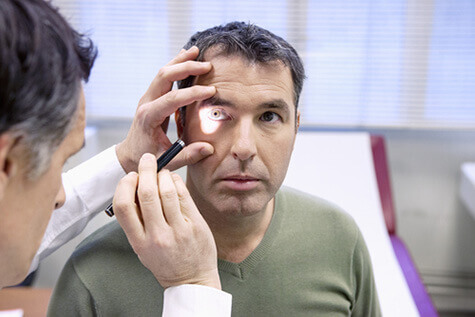
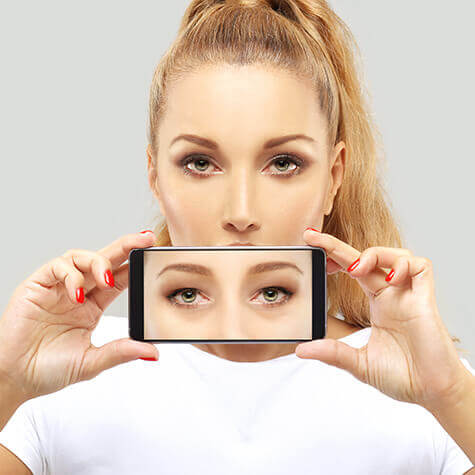
An eyelid lift, or blepharoplasty, is a surgical procedure to remove skin and fat from the eyelids. The term “eyelid lift” is a misconception because the eyelid is not lifted during surgery.
Upper blepharoplasty surgery uses incisions on the skin to allow for removal of skin and fat. A thin stitch is then used to bring the skin together to allow for a creation of an eyelid crease.
Upper eyelid excess skin and fat can create a heavy looking eyelid, aged appearance, puffiness, and sometimes block vision. Upper blepharoplasty is performed to remove excess skin and fat and can improve vision.
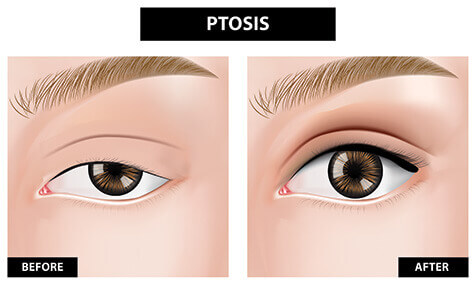
Ptosis (pronounced “toe-sis”) is the medical term for drooping of the upper eyelid(s). The upper eyelid margin may cause a reduction in the field of vision when the eyelid either partially or completely obstructs the pupil. To compensate, the patient raises the eyebrows in an effort to raise the drooping eyelids. In severe cases, people with ptosis may need to lift their eyelids with their fingers in order to see.
There are many causes of ptosis including age related weakening of the muscle, congenital weakness, trauma, or sometimes neurologic disease. As we age, the tendon that attaches the levator muscle (the major muscle that lifts the eyelid), can stretch and cause the eyelid to fall. This is the most common cause of a droopy eyelid. Ptosis may also occur following routine lasik or cataract surgery due to stretching of the muscle or tendon. Children may be born with ptosis or may acquire it due to trauma.
Ptosis can be corrected surgically and usually involves tightening the levator muscle to bring up the eyelid to provide a full-field of vision again. Two sets of visual field tests, one before and one after taping up the eyelids, and some photos are always needed to provide proof to insurance company that it is a medical necessity. Otherwise, it would be considered a cosmetic procedure and would not be covered by insurance.
Ectropion and entropion are common disorders of the eyelid margin that can directly affect ocular function and patient comfort; surgical repair is commonly performed.
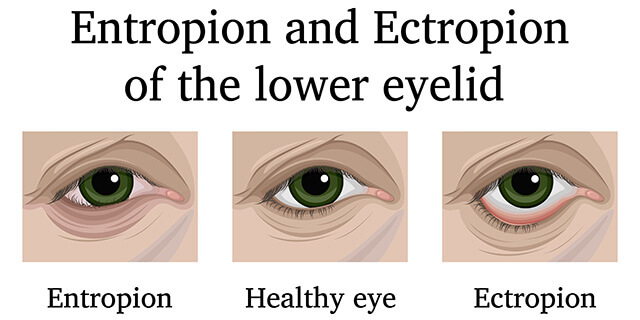
Ectropion (out-turning of the eyelid) can present with chronic eye irritation, infection, and dermatitis, among other signs and symptoms. Tearing is a common, irritation, and exposure to dry eyes. Left untreated, corneal scars can form. Mild conditions can be treated with frequent lubrications. Moderate to severe cases require surgical treatment by tightening the affected lower eyelid.
Entropion (in-turning of the eyelid) presents as an irritated eye with foreign-body sensation caused by inwardly rotated eyelashes and eyelid skin. The eye is red from constant rubbing of the eye surface by rough eyelid skin. Most patients end up needing surgery to repair it.
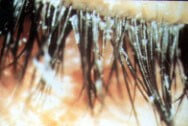
One of the most common eyelid problems is blepharitis, or inflammation of the eyelid margin. Typical symptoms are itching, burning, mild foreign-body sensation, tearing and crusting around the eyes on awakening. Blepharitis occurs with chronic bacterial lid infection, oil gland dysfunction, seborrhea and acne rosacea that affects the eye, known as ocular rosacea.
Treatment of blepharitis consists initially of warm compresses, eyelid scrubs and application of antibiotic ointment. Warm compresses should be applied for 15 minutes twice a day. The eyelids should be scrubbed after the warm compress is removed. Baby shampoo mixed with water produces a soapy solution. With the eyelids closed, the eyelid margin region should be gently scrubbed with this solution, using a cotton-tipped applicator, wash cloth or finger. Antibiotic ointment should be applied only at bedtime, because it may temporarily blur vision. If an obvious infection is present, antibiotic eye-drops may also be used.
Blepharitis is a chronic disease and eyelid hygiene may need to be continued indefinitely. When the process is brought under better control, once-daily eyelid scrubs may be sufficient to keep the problem in check.
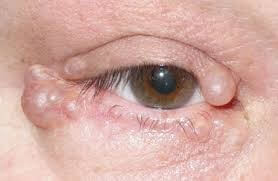
These are benign lesions due to blockage of glands in the eyelid skin. They can be excised if they are large or causes irritations.
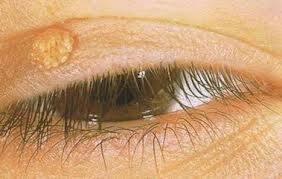
Papillomas are benign lesions; sometimes caused by a virus. They rarely require surgery except when they cause irritation.
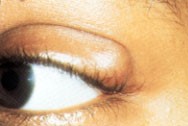
Chalazia appear most commonly as chronic subcutaneous nodules within the eyelid. Initially, a chalazion may be tender and erythematous before evolving into a non-tender lump. Blepharitis is frequently associated with chalazia.
A chalazion results from the obstruction of the eyelid oil gland. The blockage of the gland’s duct at the eyelid margin results in release of the contents of the gland into the surrounding eyelid soft tissue. For the first few days, a chalazion can cause severe discomfort. Occasionally, chalazia become infected.
Management includes warm compresses applied for 15 minutes four times a day. Blepharitis, if present, should be treated. A topical antibiotic may be used if signs of infection are present. If the lesion persists after four weeks of medical therapy, it may be incised and drained. Rarely, the chalazion is injected with steroids; however, this may result in hypopigmentation of the overlying skin.
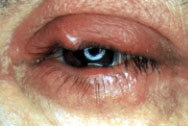
A hordeolum, also known as a stye, is an acutely presenting, red, painful lump within the eyelid. A stye can result in infection of the oil gland and may evolve into a chalazion. Styes usually drain spontaneously after one week of treatment with warm compresses 3-4 times a day and topical antibiotic ointment nightly. Incision and drainage are required for non-resolving lesions.
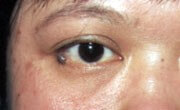
Nevus is the medical term for mole or birthmark. Moles are well-defined, flat or raised, dark or light lesions from birth. They may become darker, more raised or cystic during adolescence or young adulthood. Darker moles can turn into cancer. Therefore moles that have changed appearance should be removed and examined for cancer.
Basal cell carcinoma makes up more than 90% of eyelid cancers. The lower eyelids are involved in more than 70% of cases, followed by the corner of the eye, upper eyelid and the side corner of the eye. This cancer can cause significant damage to the eyelid. It can recur (come back) to the same area or nearby if the entire tumor is not removed. The tumors usually do not spread to lymph nodes or distant organs.
Squamous cell carcinoma occurs less often on the eyelid than basal cell carcinoma, but it is more aggressive. It can spread to nearby lymph nodes and other parts of the body. The main treatment for this type of eye cancer is surgical removal. Radiation therapy or other treatments may be used in addition to surgery if a large area is affected or if the tumor cannot be fully removed.
Melanoma accounts for about 1% of eyelid cancers. It is a potentially life-threatening type of skin cancer that can affect the eyelid skin or the conjunctiva (the soft pink tissue covering the white part of the eye). It is very aggressive and may present with early metastasis in the nearby lymph nodes that drain an eyelid or conjunctival melanoma. Sentinel lymph node biopsy can help stage melanomas of the eyelid and conjunctiva and offer early interventions that increase your chances for successful treatment.
Sebaceous carcinoma (cancer of the oil glands) is a rare type of eye cancer which affects the meibomian glands of the eyelids, conjunctiva or other ocular surface structures. These glands normally produce the oily layer of the tear film, the liquid layer that covers the eye. It can be mistaken for non-cancerous conditions like a chalazion, a small cyst known as a stye. If a stye does not heal with medical treatment or surgical drainage, a biopsy should be done. Treatment requires surgical removal, and the defect in the eyelid is reconstructed with various techniques depending on the size and location of the tumor. Sometimes topical chemotherapy is used after the surgical area has healed.